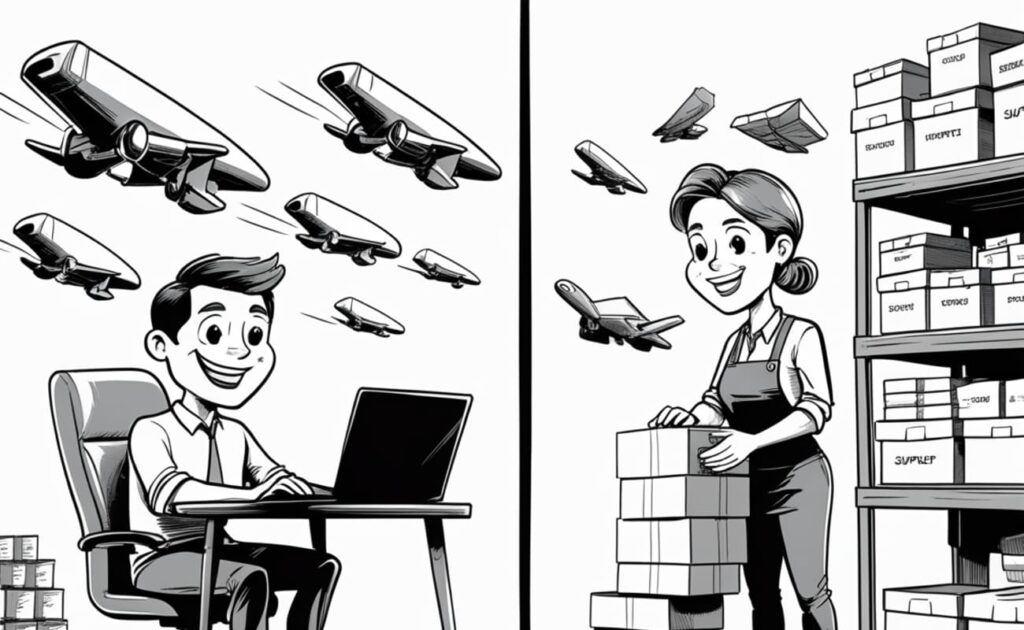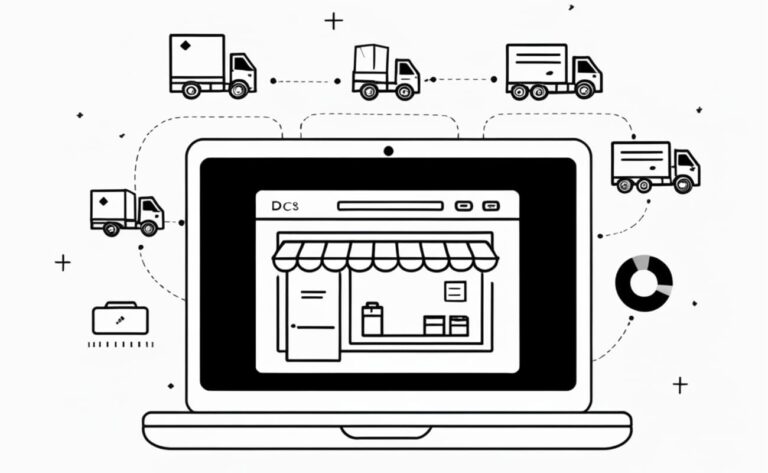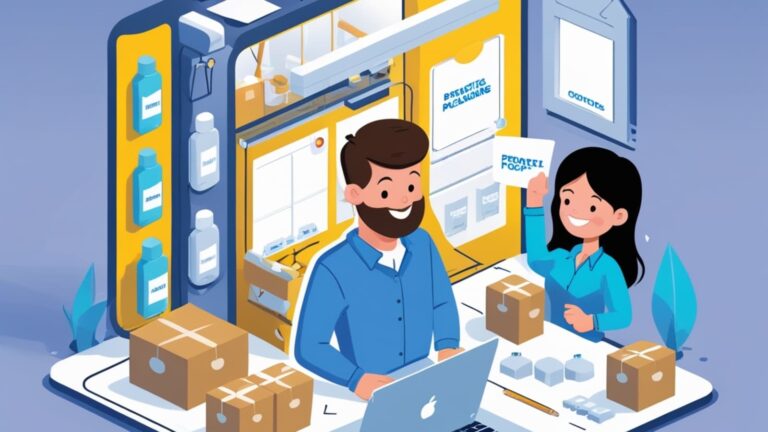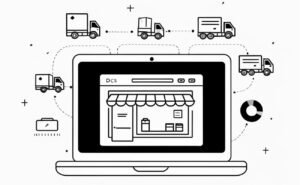Are you curious about the key differences between traditional ecommerce and dropshipping models? In 2025, the debate of dropshipping vs ecommerce has taken center stage among entrepreneurs, digital marketers, and even teenagers looking for a side hustle. In this article, we’ll delve into an analytical comparison between these two business strategies by focusing on three core areas: operational structure, financial risks, and execution challenges. As you read through, consider your own business aspirations and ask yourself, “Which model aligns with my long-term vision?”
Before we proceed, feel free to explore our detailed insights on the dropshipping salary and discover how home-based ventures can be lucrative. For more comprehensive information on ecommerce and online business models, you can always visit our homepage at Smarteconomix and check out trusted sources like Investopedia.
Understanding the Operational Structure
When comparing Dropshipping vs Ecommerce, the first area to analyze is the operational structure. Essentially, the two models differ markedly in inventory management, supply chain logistics, and capital requirements. Traditional ecommerce typically involves purchasing, stocking, and shipping products yourself. This means you have full control over quality management and order fulfillment but must invest heavily in inventory and warehousing. On the other hand, the Dropshipping vs Ecommerce model shows that dropshipping minimizes these responsibilities by relying on third-party suppliers to directly ship products to your customers. This reduction in logistical overhead can be a significant advantage for those with limited startup capital.
These Dropshipping vs Ecommerce differences can heavily impact how you manage day-to-day operations. For instance, with a dropshipping model, there is less worry about inventory management, which means you can quickly test multiple product niches with minimal risk. However, the less direct control over product quality and shipping times might affect customer satisfaction. Have you ever wondered if having less control might compromise your brand’s reputation? That’s a common concern discussed in Dropshipping vs Ecommerce forums.
Dropshipping vs Ecommerce: Which Operational Model Fits Your Business?
It isn’t simply a matter of better or worse—Dropshipping vs Ecommerce is about what works best for your unique circumstances. If you desire to build an established brand with high quality standards, ecommerce could be the ideal route. Conversely, if your goal is to test product ideas quickly, the dropshipping model could be the perfect launchpad. Many entrepreneurs share their experiences on platforms like Dropshipping vs Ecommerce Reddit, where real-life testimonials emphasize the pros and cons of each approach.
Analyzing Financial Risks
Next, let’s dive into the financial risks inherent in the Dropshipping vs Ecommerce debate. Financial risk can be analyzed in terms of startup costs, cost structures, and potential returns. With traditional ecommerce, the initial investment is typically higher because you need to purchase inventory upfront, lease storage space, and sometimes invest in staffing. The financial risk includes fixed costs and the danger of overstocking items that could go unsold. Dropshipping vs Ecommerce analysis shows that dropshipping, however, has lower startup costs and a more variable cost structure, meaning you only pay for products after you make a sale. This makes it a less daunting option for those with limited capital.
Despite having lower fixed costs, the Dropshipping vs Ecommerce model reveals that dropshipping also comes with its own set of challenges. The profit margins can be thinner because the dropshipping supplier often takes a cut, and shipping issues can create unexpected expenses. Moreover, many dropshippers face the risk of market saturation, leading to fierce competition which, in turn, erodes profit margins even further. So, when considering Dropshipping vs Ecommerce, one essential question is: Would you prefer to bear a high upfront cost for potentially higher margins, or opt for low investment with a flexible but sometimes unpredictable financial outlook?
Differentiating Costs: Fixed vs Variable
The financial structure of ecommerce businesses typically involves more fixed costs, such as warehousing and initial inventory purchases. In contrast, dropshipping is characterized by variable costs tied to actual sales. This direct correlation with sales can be an advantage if everything goes as planned, but also a disadvantage during slow periods. Entrepreneurs should evaluate the risks based on their ability to absorb these costs and their approach to managing cash flow.

Overcoming Execution Challenges
Execution challenges remain a crucial factor in the debate between ecommerce vs dropshipping. Traditional ecommerce often requires rigorous quality control, dedicated customer support, and robust logistics management. Each step, from packaging to shipping, needs careful attention to detail. Conversely, dropshipping presents different challenges by relinquishing some control over the supply chain, meaning potential delays or quality issues could adversely affect customer satisfaction. Have you ever experienced frustration when a product’s packaging doesn’t quite meet expectations? This is a common concern in dropshipping models where the quality of the customer experience is somewhat in the hands of third parties.
The reality is that both systems have scale-related challenges. Growing an ecommerce brand might require a significant overhaul of your internal processes and infrastructure, while scaling a dropshipping operation often involves finding reliable suppliers and managing an increasingly complex order flow. In many discussions online, particularly in threads about dropshipping vs ecommerce difference on platforms like Reddit, entrepreneurs have shared that execution challenges can often define whether their business becomes a success or not.
Managing Customer Relationships and Quality Control
Customer relationship management and consistent quality control are paramount to maintaining a successful business, regardless of the model. In traditional ecommerce, you have the opportunity to oversee everything from product selection to presentation, giving you the power to build a consistent brand image. In a dropshipping scenario, however, much of the product experience is outsourced, which could result in unexpected variations. These challenges call for strategic planning and constant vigilance—both essential qualities for any entrepreneur looking to thrive in the competitive world of online sales.
Empirical Data: A Comparative Review
Now that we have explored the structural and qualitative differences between dropshipping and traditional ecommerce, let’s examine some objective data. The following table summarizes key metrics that can help you understand where these models differ financially and operationally:
| Metric | Dropshipping | Traditional Ecommerce |
|---|---|---|
| Startup Costs | Low – No inventory holding required | High – Inventory, warehousing, staffing |
| Profit Margin | Lower – Competitive pricing and supplier fees | Higher – Controlled pricing and inventory pricing |
| Return on Investment (ROI) | Variable – Dependent on market trends and supplier reliability | Relatively Stable – More predictable after establishment |
| Failure Rate in Year One | Approximately 80%* – Due to market saturation and quality issues | Lower – Though risks from high investments exist |
| Operational Control | Lower – Reliance on third-party logistics | Higher – Complete management over inventory and delivery |
* Note: The 80% failure rate mentioned for dropshipping within the first year is reflective of numerous industry reports and should be interpreted within context. Actual outcomes can vary widely based on execution and market factors.
This empirical analysis highlights the cost and risk trade-offs between the two models. As an entrepreneur, understanding these metrics can empower you to make a data-driven decision on which pathway to pursue. Have you weighed the importance of high control versus low initial financial risk in your business planning?

Optimizing Your Strategy: When to Choose Which Model
Ultimately, the decision between diving into dropshipping or establishing a traditional ecommerce brand depends on your business goals, risk tolerance, and available resources. In the ongoing Dropshipping vs Ecommerce debate, understanding your priorities is key. For instance, if you’re just starting out or testing a market concept without considerable financial risk, Dropshipping vs Ecommerce analysis shows that dropshipping offers a viable route. It allows you to experiment with various products and niches without the burden of unsold inventory. In fact, many newcomers have successfully mined profitable niches thanks to the flexible nature of dropshipping—making it a strong contender in the Dropshipping vs Ecommerce conversation.
On the other hand, in the Dropshipping vs Ecommerce comparison, if you are ready to invest in your brand’s identity and want to deliver a highly curated customer experience, traditional ecommerce might be preferable. You gain deeper control over product quality, shipping, and post-sale customer interactions—a critical factor if you’re targeting high-margin, premium products. Have you ever thought about whether a high level of control might be worth the increased initial investment? That’s one of the most crucial decisions in the Dropshipping vs Ecommerce journey.
For many experienced entrepreneurs, the best approach in the Dropshipping vs Ecommerce landscape is sometimes a hybrid strategy. For example, starting with dropshipping allows you to gauge market demand, develop robust marketing channels, and test customer preferences. As your business matures, you can gradually transition to traditional ecommerce by investing in inventory and full-scale operations. This phased approach helps mitigate early financial risks while eventually capitalizing on higher profit margins—illustrating a practical balance in the Dropshipping vs Ecommerce spectrum.
In my personal experience, the journey of comparing Dropshipping vs Ecommerce has taught me that flexibility and willingness to adapt are essential. Online business is inherently dynamic—what works well today might evolve tomorrow. As you ponder your own decision, keep an eye on the latest trends and industry reports that continue to shape the competitive landscape between Dropshipping vs Ecommerce.
Conclusion
By now, it should be clear that the debate over dropshipping vs ecommerce is not about which is universally better, but rather which model is better suited to your specific needs and growth objectives. Operationally, dropshipping offers low barriers to entry and flexibility, while traditional ecommerce provides greater control and potentially higher profit margins, albeit with higher startup costs and execution challenges. Your choice will largely depend on your appetite for risk, financial readiness, and long-term business vision.
We invite you to reflect on these insights: What are you looking for in your business model—speed and flexibility or control and stability? Would you consider starting with a low-cost dropshipping approach and gradually transitioning into a more controlled ecommerce environment once you understand your target market better?
FAQ
1. Dropshipping vs Ecommerce: Which is Better?
The answer depends on various factors such as startup capital, risk tolerance, and business goals. Dropshipping is ideal for those testing the market with minimal investment, while traditional ecommerce may be more suitable for entrepreneurs who want full control over product quality and customer experience.
2. What are the Key Differences Between Dropshipping and Traditional Ecommerce?
The primary differences include operational structure (inventory management, warehousing), financial risks (fixed versus variable costs), and execution challenges (quality control, customer management vs reliance on external suppliers). Each model comes with its own set of pros and cons that fit different business scenarios.
3. What Insights Can be Gained from Dropshipping vs Ecommerce Reddit Threads?
Users on Reddit typically share personal experiences regarding both models, discussing topics such as market competition, supplier reliability, and financial outcomes. These real-life accounts often highlight the unpredictability of dropshipping with its lower startup costs yet higher risk of customer dissatisfaction, as opposed to the controlled environment of traditional ecommerce.
4. How Can I Mitigate the Risk of Low Profit Margins in Dropshipping?
Consider investing in robust supplier partnerships, optimizing your marketing strategies, and gradually exploring hybrid models. Building a strong brand identity even within a dropshipping framework can help improve customer trust and potentially drive higher profit margins over time.
5. Is a Hybrid Model a Viable Option Between Dropshipping and Ecommerce?
Absolutely. Many successful entrepreneurs begin with dropshipping to test the market and later transition toward a traditional ecommerce model by investing in inventory as they understand their customer base better. This phased approach helps reduce initial risks while eventually leveraging the benefits of both models.









